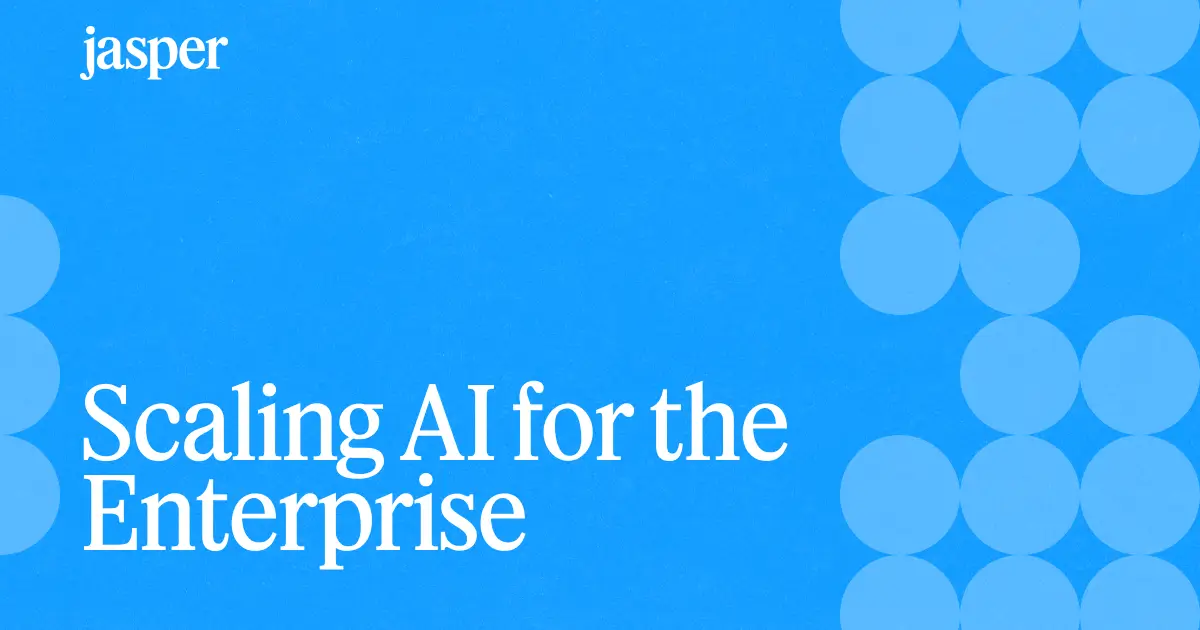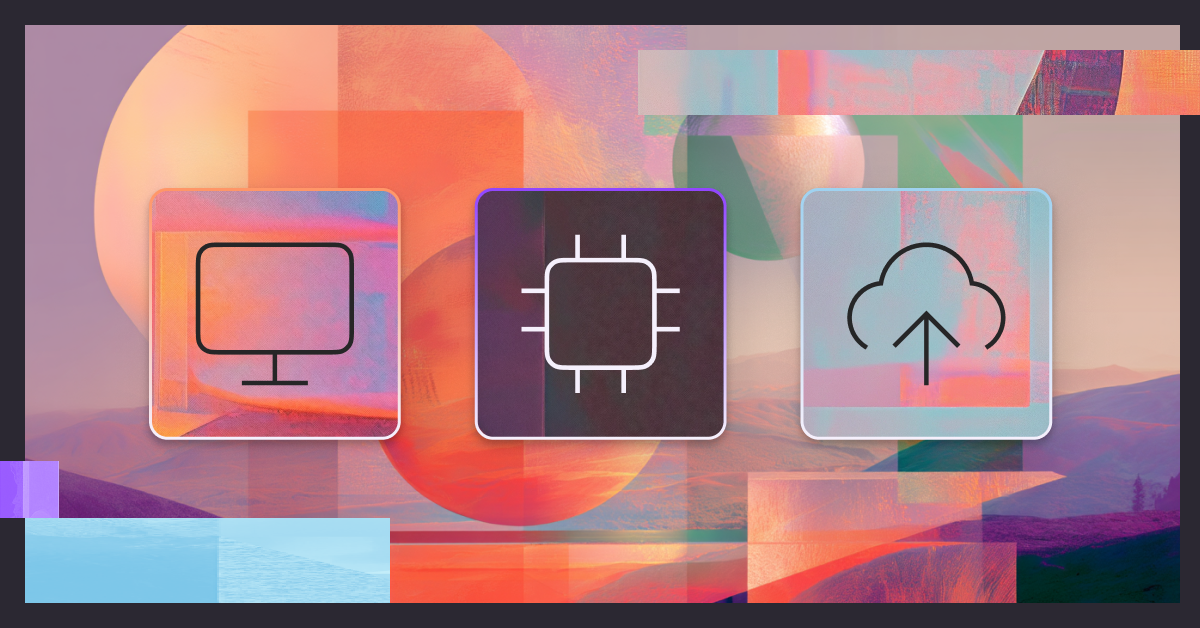How AIDA Marketing Works (and How to Make It Work For You)
Need a fail-safe marketing framework for your content strategy? Learn more about AIDA marketing, examples of using it, and drawbacks to watch out for.

Whether you are writing website copy, social media posts, or blog content, marketing frameworks can help improve your efficiency and effectiveness. There are several frameworks to choose from, but the AIDA model is one of the oldest and most popular in the industry.
The AIDA framework enables content marketers to simplify the content creation process, and AI tools like Jasper help you create compelling content within the AIDA framework even faster.
In this article, we’ll explore the AIDA model and how to use it. We’ll also explore how AI tools help you scale your content using the AIDA framework.
What is the AIDA copywriting model in marketing?

Developed in 1898 by St. Elmo Lewis, AIDA is a selling model that follows the customer journey from product awareness to purchase. The AIDA model works as a funnel to convert prospective customers into buyers.
AIDA follows four steps:
- Attention
- Interest
- Desire
- Action
Why is AIDA valuable?
As a busy marketer, entrepreneur, or business owner, it’s critical that you know how to create effective content. The AIDA model saves time while empowering organizations to generate effective marketing strategies.
Maximizing marketing efforts
AIDA acts as a template to optimize your marketing strategy. Businesses use this model to focus their marketing efforts and better influence the customer journey, boosting conversions and sales.
By following a proven template, marketers and business owners can speed up the content development process. This allows for more efficient use of resources, while still maintaining a high quality of content.
AIDA also helps to ensure that all key elements of a successful marketing campaign are addressed, such as understanding customer needs and crafting compelling messaging.
Building better relationships with customers
The AIDA model encourages marketers to understand their customers better. Each step deepens the emotional connection between the consumer and the brand. As a result, businesses offer a more personalized customer experience. When customers feel understood and valued, they are more likely to engage with the brand and become loyal advocates. This leads to long-term customer relationships and increased customer retention.
Tailoring messaging for different audiences
One of the most significant benefits of AIDA is its versatility. The model can be applied to various marketing channels, audiences, and industries. It allows marketers to adapt their messaging to different audiences and effectively target specific customer segments. This level of personalization can significantly increase the chances of converting leads into paying customers.
How to apply the AIDA model in your marketing strategy, with examples
Without proper implementation, even the best formulas can seem abstract. Let’s explore the four steps of the AIDA model and how to apply them in real life.
Step 1: Attention

Attention is the customer’s response when they learn about your brand. The attention stage should define your outreach strategy, driving brand awareness and curiosity.
The most popular marketing channels for first encounters are search engines, ads, and social media.
This is the stage where businesses differentiate themselves. Here are a few ways to get customer attention:
- Entertaining your audience with funny quotes or GIFs on social media
- Guerrilla marketing
- Creating shock
- Using personalized messaging
Example: Venture firm Fifth Wall uses memes to connect with its target audience.
In this example, the fund—which invests in real estate, property, and climate technologies—builds brand awareness with a scene from the television show The White Lotus:

On social media, memes can be a great way to gain users' attention with humor. This meme is effective because it matches the brand’s voice and ties back to the company’s mission. Fifth Wall also posted this the day after the show’s finale while it was trending on Twitter.
Example: Paramount Pictures placed actors in stadiums in several Major League Baseball games to promote their horror movie Smile. The actors, visible behind home plate, smiled creepily at the camera for extended periods:

This strategy uses guerrilla marketing to be memorable. Paramount connected with the movie’s target audience during an unrelated public event, creating a lasting impression.
Step 2: Interest

Once you’ve captured your audience’s attention, the next step is to get them to like you—in other words, to generate interest. The Attention phase often takes shoppers from a search engine results page or social media to your homepage or blog. Then, it’s up to you to hook them with engaging content.
Here are some ways to keep potential customers interested:
- Writing strong web copy—landing pages should highlight your strengths
- Creating informative blog content and shareable resources
- Leveraging user-generated content to build social proof
Example: Cleo, a money app targeting Gen Z, uses clever copy and edgy animated visuals on its homepage page to entice them to learn more:

By using language and visuals tailored to Gen Z users, the company effectively communicates their message to its target audience.
Step 3: Desire

Once you have a customer’s interest, how do you motivate them to buy? The desire stage occurs when your customer moves from liking your product to wanting it.
Brands generate desire by building trust. Before-and-after photos, testimonials, and case studies establish credibility and help move your target audience down the purchase funnel.
Example: At Jasper, we use real customer reviews to build trust and show the value of our product:

Example: Ritual, a health and wellness brand, reveals the process of creating an essential vitamin for women. By taking customers behind the scenes, the brand highlights its credibility.

Step 4: Action

This final step prompts your customer to act. This is where you offer a compelling call to action (CTA). Whether you want customers to purchase a product or sign up for a free trial, you should make the process as easy as possible and create a sense of urgency.
Example: Headspace, a meditation app, uses “Send a gift” as a CTA, making it effortless for customers to purchase a subscription to the app during the holidays.

Headspace knows that its users likely have holiday shopping on their to-do list. The company makes gift-giving easier with one click.
3 Tips to succeed with AIDA
Now that we’ve defined AIDA, let’s explore how to use the framework. Here are three tips to make the most of your AIDA strategy:
1. Understand your target audience
Identifying your target customer is essential to success with the AIDA model. If your potential customers are not on TikTok, even the best video won’t generate attention for your brand.
Similarly, suppose a potential customer visits your website and does not see themselves represented in your marketing imagery. They will likely walk away instead of moving down the funnel.
To better understand your target audience for successful implementation of the AIDA model, consider the following strategies:
- Conduct surveys and gather feedback directly from your current customers to learn about their preferences, needs, and pain points.
- Utilize analytics tools to track user behavior on your website and social media platforms to gain insights into their interests and interactions with your content.
- Engage with your audience through social media polls, Q&A sessions, and discussions to foster a sense of community and gather valuable feedback in real-time.
- Create buyer personas based on demographic data, psychographic information, and behavioral patterns to tailor your marketing messages effectively.
- Monitor industry trends, competitor strategies, and market research to stay informed about changes that may impact your target audience's preferences and behavior.
2. Speak to your audience’s pain points
Listing benefits, statistics, or awards can be tempting to gather attention. However, your audience should be at the center of each stage of the AIDA model. Focus on your audience’s pain points and how your product or service will solve them. This approach will help you build an emotional connection with your audience and create a sense of urgency for them to take action.
Some effective ways to speak to your audience’s pain points include:
- Identifying the specific problems or challenges they are facing
- Sharing relatable stories or testimonies from satisfied customers
- Highlighting the consequences of not addressing their pain points
- Offering a solution that directly addresses their pain points
By understanding and addressing your audience’s pain points, you can position your product or service as the ideal solution for them. This will not only grab their attention but also make them more likely to take action.
3. Avoid clickbait
Over-exaggerated language and clickbait tactics may generate attention, but you risk losing your customers’ trust from the start. Use direct language to build credibility with customers.
Using clickbait in marketing can have several drawbacks. Cickbait often relies on over-exaggerated language or misleading headlines to attract clicks, which can lead to a negative user experience when the content fails to deliver on the promised expectations. This can result in a loss of trust and credibility with your audience, ultimately harming your brand's reputation in the long term.
Clickbait tactics may also drive short-term traffic spikes, but they usually result in high bounce rates as visitors quickly realize they have been misled. This means that using clickbait can be detrimental to building genuine engagement and fostering lasting relationships with potential customers.
The bottom line here is that the negative effects of clickbait on customer trust and brand perception far outweigh any short-lived benefits it may bring in terms of initial clicks.
Drawbacks of the AIDA copywriting model
We know the AIDA model works, but is it always effective? Not necessarily. Here are the major drawbacks of the model and some suggestions to help you work around them:
The AIDA model is formulaic
This framework ignores the fact that not all buyers follow the same pattern. Some buyers are more decisive and will make impulse purchases. Other customers may jump back and forth between stages before taking action.
A seamless customer journey is essential. Companies should make it easy to move through each step.
Here are some ways to facilitate that:
- Including CTAs at every stage
- Optimizing links for both web and mobile
- Sending cart abandonment emails or SMS notifications to re-engage potential customers
The AIDA model is only one piece of the puzzle
AIDA focuses on first-time purchasers. It often overlooks opportunities to drive sales, including options for cross-selling and upselling. While the AIDA model should be a part of your strategy, you will still need to have a plan to reach customers whom the framework might miss.
The AIDA model does not address the post-purchase experience
With the AIDA framework, the customer journey ends at the action stage. The model doesn’t account for the post-purchase experience, such as referrals, returns, customer retention, and customer satisfaction.
It’s essential to consider building customer loyalty and turning customers into brand ambassadors after they buy a product.
To combat the limitations of the AIDA model, you should follow up with customers outside this framework. This includes reaching out to segmented email marketing lists, using referral software services, and incentivizing customers to leave reviews or share their products on social media.
But all this doesn’t mean we should abandon the AIDA framework. When used correctly, it’s still a great place to start the customer journey.
Examples of the AIDA copywriting model in action
Before we look at how AI tools can accelerate the AIDA process, let’s look at a few examples of companies that used all stages of AIDA in their copy.
Sizze
First, check out this Facebook ad from SaaS company Sizze. Can you spot the four stages of the AIDA model?

- Grabs attention: Starts with an immediate mention of “The best deal in 2022” and offers an incentive
- Holds interest: Lists the product’s benefits while speaking to customers’ pain points
- Heightens desire: Reminds customers of the perk mentioned at the outset of the ad and why it’s valuable
- Encourages action: Ends with a clear and simple CTA
The Sill
Second, this email is from the direct-to-consumer plant brand The Sill:

- Grabs attention: The headline generates curiosity—why is a plant brand reaching out about National Cat Day?
- Holds interest: Sub-headline “Non-Toxic Plant Picks” creates an emotional connection for cat owners and plant lovers
- Heightens desire: Speaks to customers’ desire to keep their “curious companions” safe
- Encourages action: Ends with a clear CTA button
Clare
Finally, this landing page is from paint brand Clare:

- Grabs attention: Starts by appealing to their audience’s pain points (e.g., stress-free)
- Holds interest: Lists unique benefits of the brand, like peel-and-stick swatches and designer-curated colors
- Heightens desire: Uses imagery to share unique perks like free shipping
- Encourages action: Includes a direct CTA button
How Jasper helps you use the AIDA marketing framework
AIDA marketing can be highly effective, but providing the same quality content for a large number of clients or copy projects can be exhausting.
What if there was an easier way to apply the AIDA marketing framework?
Jasper is an AI writing assistant designed to help you scale your content marketing strategy. With over 50 templates—including a specific AIDA Framework template—Jasper enables you to generate content up to 10 times faster.
Let’s look at the AIDA Framework template in action:
First, it asks you to tell Jasper about your product and service. Using the AIDA framework, it then uses your inputs to create copy:

What’s particularly notable is that Jasper highlights which part of the framework each paragraph tackles. This ensures you hit every pain point and highlight your product’s critical features.
The AIDA Framework template can also help with various types of copy. For instance, Jasper’s recommendations below would make compelling ad copy:

The length of each output is suitable. Each output starts with an engaging question relevant to an SEO agency’s ad audience and uses data to build credibility. And Jasper even added some additional flair by including years of experience and information about custom SEO plans.
You can use the AIDA model and framework for just about anything, from blog post introductions to sales pages.
For example, Jasper’s outputs below could make an engaging YouTube video description:

YouTube video descriptions should capture your audience’s attention, provide a short description, and include a call to action. Jasper’s outputs speak to the audience’s pain points while promising a solution and offering expertise.
Enhance your AIDA framework content strategy with Jasper
The AIDA model may have begun in the 19th century, but it still works like a charm. While the AIDA framework helps save you time, you can make even more efficient use of it by scaling your content with Jasper.
Using the AIDA Framework template, Jasper acts as a brainstorming partner to help you supercharge your copywriting. And with more than 50 other templates, Jasper can meet all your content creation needs.
Sign up today to see how you can use Jasper to create captivating copy with the AIDA framework.
More of the latest & greatest

Scaling AI for the Enterprise: How Marketing Leaders Drive Impact
High-performing marketing teams are scaling AI with structure and strategy. Learn how CMOs can lead the way to drive organization-wide impact.
July 1, 2025
|
Megan Dubin

Reflections from Cannes: Why Brand and People Still Matter Most in the Era of AI
At Cannes Lions 2025, one truth stood out: brand, trust, and authenticity are making a powerful comeback.
June 24, 2025
|
Loreal Lynch

Interactive Tool: Benchmark Your AI in Marketing Strategy
Discover your marketing team's AI maturity. Benchmark your strategy, compare with peers, and uncover gaps with an interactive tool.
June 17, 2025
|
Megan Dubin







